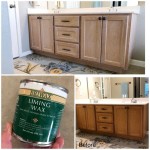Do You Need to Sand Cabinets Before Staining?
Staining cabinets is a popular way to refresh a kitchen or bathroom. It can transform the look of your space, offering a modern or traditional feel depending on the stain color chosen. However, before you begin the staining process, one question arises: Do you need to sand your cabinets before staining?
The answer is a resounding yes, and it is essential for achieving a smooth, even, and long-lasting finish. Sanding cabinets before staining serves several crucial purposes:
Creating a Smooth Surface for Stain Absorption
Cabinet surfaces often have imperfections such as scratches, dust particles, or even old finishes. These imperfections can interfere with the stain’s absorption, resulting in an uneven and patchy finish. Sanding helps create a smooth surface that allows the stain to penetrate evenly, leading to a consistent color and a beautiful aesthetic.
Removing Existing Finishes
Old finishes, whether paint or varnish, can create a barrier that prevents the stain from adhering properly. Sanding helps remove these existing finishes, allowing the stain to penetrate the wood directly. If you are re-staining cabinets, sanding is particularly important to strip away any old stain before applying the new one. Ensure you use the appropriate sandpaper grit to remove the existing finish without damaging the wood.
Enhancing Stain Adhesion
Sanding creates tiny scratches and imperfections in the wood's surface, increasing its surface area. This increased surface area provides better adhesion for the stain, ensuring it sticks firmly to the wood and lasts longer. A well-sanded surface is like a canvas that welcomes the stain, creating a durable bond that resists chipping or peeling.
Important Considerations When Sanding Cabinets
While sanding is essential before staining, it's vital to do it correctly to avoid damaging your cabinets. Here are some key considerations:
Choosing the Right Sandpaper Grit
Select the appropriate sandpaper grit based on the existing finish and desired outcome. Begin with a coarse grit, like 80 or 100, to remove old finishes or significant imperfections. Progress to a finer grit, such as 150 or 220, to smooth out the surface. Finish with a very fine grit like 400 or 600 to achieve a polished and even surface.
Sanding Direction
Sand in the same direction as the wood grain. Sanding across the grain can create scratches that will be visible even after staining. This is especially important when sanding cabinets with visible wood grain, such as oak or maple.
Work in Sections
Sand your cabinets in small sections to avoid uneven sanding or excessive pressure. Overlapping the sections slightly will help ensure a seamless finish. Don't press too hard, as this can damage the wood. Use light, even strokes to achieve the best results.
Cleaning and Vacuuming
After sanding each section, wipe away dust and debris with a tack cloth or a slightly damp cloth. This will prevent dust particles from getting trapped in the stain and marring the finish. Thorough cleaning is critical for a smooth and flawless result.
Sanding cabinets before staining may seem like an extra step, but it is crucial for achieving a professional-looking finish. By following these guidelines, you can ensure your cabinets are properly prepared for staining, resulting in a beautiful and long-lasting transformation for your kitchen or bathroom.

How To Paint Kitchen Cabinets A Step By Guide Confessions Of Serial Do It Yourselfer

Staining Your Wood Cabinets Darker Young House Love

Staining Your Wood Cabinets Darker Young House Love

A Guide To Painting Kitchen Cabinets Norton Abrasives

How To Paint Kitchen Cabinets Without Sanding Or Priming

Prep And Paint Cabinets Without Sanding

Painting Oak Cabinets White An Amazing Transformation

How To Stain Oak Cabinetry Tutorial The Kim Six Fix

Yes Paint Over Stained Wood Without Sanding Porch Daydreamer

What You Need To Know Before Painting Cabinets The Palette Muse
Related Posts








